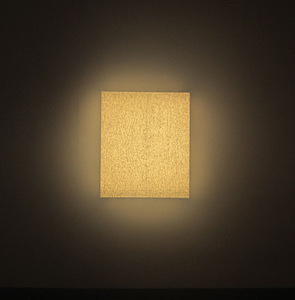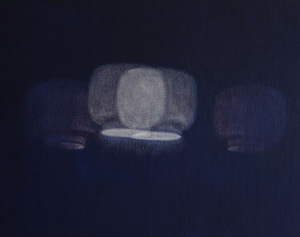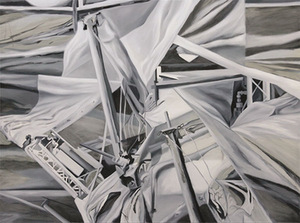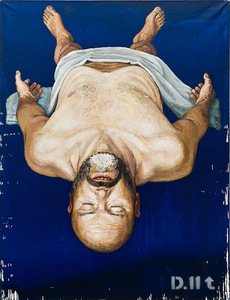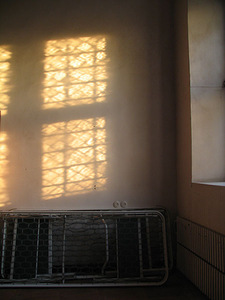On Ash trees, thorns, time and death 6
In brief: Visual art, which has long stopped representing (only) the area of mimesis, often appears as a framework or structure that does not picture anything; as a code, a citation, a link, a comment or something that is in between, (founding) claiming its own reality. Of course, artistic creation is only a small part of a machinery that manufactures alternative realities and a painting exhibition "The relevance of Reality" held in Lithuanian Artists' Association gallery Meno Parkas in Kaunas only partly reflects their diversity.
The structure of this exhibition is based on a dialog. Works of Povilas Ramanauskas, Rosanda Sorakaitė and Eimutis Markūnas are all about light, but with different connotations. P. Ramanauskas object "Homage to a Painting" is a light box, covered with canvas - it does not depict anything but itself. This self-referent piece that discusses only itself and tells about painting and its limitations belongs to the paradigm of modernist art. In 19th century, when photography appeared next to the visual arts, the foundation of fine art started to wobble. Then, essential questions related to the image revolution were raised and fierce debates on painting as a medium started but it is doubtful whether most of them remained equally relevant today. Especially those that question the formal foundation of the piece. Matter and form are relevant only to the extent that they "carry" a certain semantic meaning - are based on a unique mythology.
Quite different is the dynamic and multi-layered Eimutis Markūnas installation "Verticals". They are vertical bulks lit from behind, "painted" in human body prints that are accompanied by sound. This eloquent piece of art fusion is about a human and his footprints in time. Although at first glance the installation seems extravagant (this effect is enhanced by the minimalist works of P. Ramanauskas and R. Sorakaitė), in reality, behind this impressive surface lies a profound idea of human fragility and transience.
The exposition is finished with Ignas Gleixner video work "Blossoming" that reflects the cycle of birth, growth and death. Its epicenter - a circle formed from tree bark in a forest swamp, in which meditatively floating thorns gradually fill the artificial pond's surface. Once the barriers that separate the inside from the outside are opened, turning and as if competing among themselves, thorns swim to the swamp and merging with its natural surroundings complete the cycle. The sound of forest (rain, murmur, bird chirping) is important. It spreads throughout the third floor of the gallery and provides the exposition with a certain mood and by interacting with the nearby pieces it highlights the aspects of life and death, secular and sacred, transience and eternity analyzed by the objects.
dovilestirbyte@gmail.com
